Drive More Nails And Make Demo Easier With These Expert-Recommended Hammers
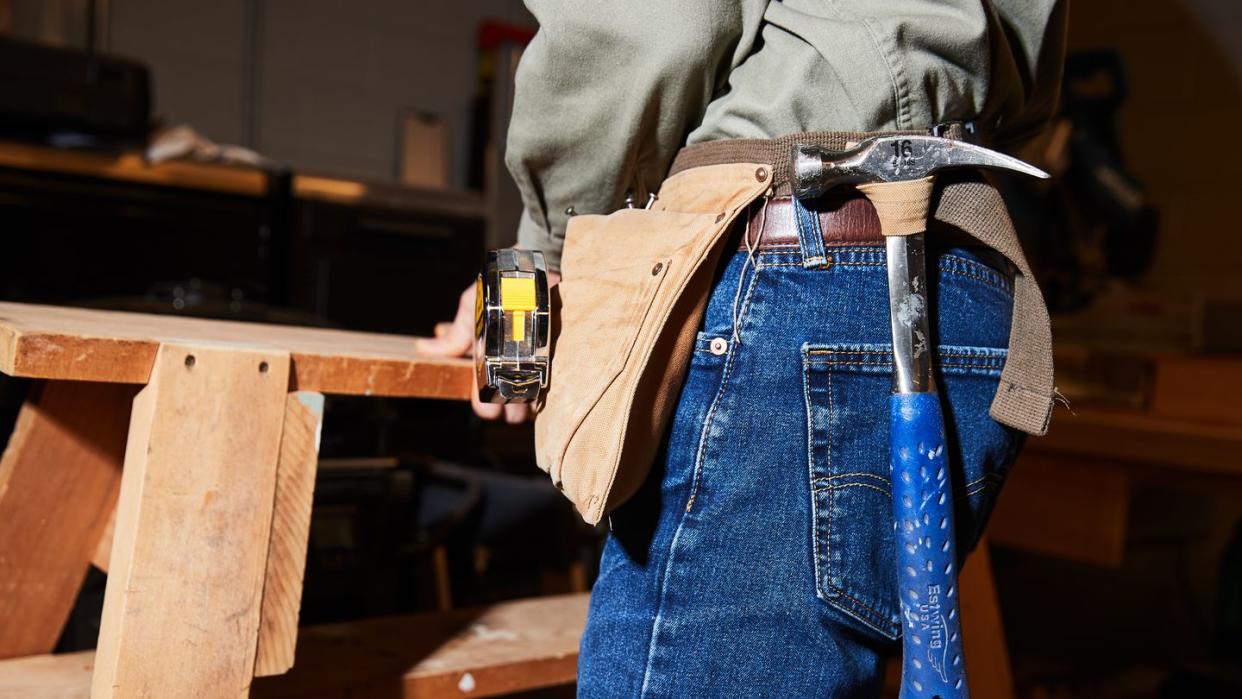
"Hearst Magazines and Yahoo may earn commission or revenue on some items through these links."
Hammers are one of the oldest hand tools in existence, and while they’ve definitely improved over time, the general concept has not changed much. Considering that a hand tool weighing just a pound or two – with no moving parts – can generate the power to drive a nail into wood, as well as the mechanical leverage to pull it out, it’s pretty obvious why hammers are still an essential piece of any tool collection.
A hammer is incredibly efficient when it comes to generating force. When used properly, you can focus a large amount of energy in one place. This is obviously useful for driving nails into wood, but hammers aren’t just about raw power. Once you start thinking of it less as a “smasher” and more as a “force amplifier”, you’ll start to see more opportunities where it could come in handy.
In addition to hammering nails of all sizes, hammers are well-suited for demolition tasks like smashing through drywall or prying boards apart, as well as striking other tools like chisels or pounding tent stakes.
Regardless of your DIY expertise or needs, practically anyone can find a hammer useful. To help differentiate the best ones for certain tasks, I used my personal carpentry and construction experience to round up the 9 best hammers below.
Best Hammers
Best Overall Hammer: Estwing 16 oz E3-16S
Best Budget-Friendly Hammer: Craftsman CMHT51398 16-oz Claw Hammer
Best Titanium Hammer: Stiletto TBM14RSC TiBone Mini-14
Best Framing Hammer: Vaughan 10300 CF 1 California Framer
Best Finish Hammer: Vaughan 122-01 9 10-Ounce Little Pro Rip Hammer
The Expert: As a former residential and commercial carpenter, I’ve used my expertise and knowledge to write about DIY, tool, and home products for Business Insider, Family Handyman, and CNN Underscored. I’ve sampled a range of hammer sizes, types, and brands over the years, using them for light-duty tapping tasks at home, driving and pulling nails on a construction jobsite, and performing renovation projects.
What To Consider
All hammers might look roughly the same, but they can differ more than you might think. To ensure that you choose the best option for you and your specific task, it’s important to be familiar with their different types, materials, and sizes.
Types
There are dozens of hammer types available, but these are the most common for the average user. While some are useful for all-purpose tasks, others are designed for specific, niche jobs, so choose carefully.
Claw: This is the most common type of hammer, and probably the first thing that comes to mind when you imagine one. Its head features a metal striking face for driving nails, and a bisected claw on the other side for pulling nails and sliding between two surfaces for prying. The design of this claw is split into two categories, curved and rip.
A curved claw has a sharper bend, which is perfect for grabbing and pulling nails out of wood more efficiently. This type of hammer is generally best for light-duty residential work, as the curved claw is less practical for the heavy-duty ripping and prying commonly required on job sites.
Rip claws are straighter than curved versions, and are better suited for prying things apart, spiking into joists or other lumber that needs repositioning, and general demolition. They’re also useful for hooking into and moving large boards or debris out of your way. While they’re not as convenient for removing nails, having a separate nail puller or cat’s paw is an easy solution.
Framing: A type of rip claw hammer, framing hammers are typically longer and heavier than other hammer types. This design allows the user to generate the force necessary to drive large nails into lumber during framing projects, as well as the leverage for prying boards apart. Framing hammers also have milled faces (a waffled texture) to add traction and prevent slippage when striking a nail. These days, framing hammers are usually used in conjunction with automatic framing nailers for maximum efficiency.
Finish: Small, light, and easy to swing accurately, finish hammers (also known as ‘trim’ hammers) are used on more delicate items like trim, molding, and furniture whose surface is visible when complete. Their smooth faces minimize the chances of a stray swing damaging the workpiece, and they're available with both straight and curved claws. These aren’t ideal for heavy-duty use, and are best paired with light-duty finish nails.
Sledge: Sledge hammers have large, extremely heavy heads for delivering maximum force, making them perfect for demolition tasks, driving large tent stakes, or splitting firewood with a wedge. These hammers are available with a range of handle lengths and various head sizes/weights, allowing you to choose the best option for your task. Since their two-sided heads have no claw, sledge hammers are strictly for striking purposes.
Mallet: Instead of metal, mallets have heads made of rubber, nylon, or wood, allowing you to apply force to delicate or fragile materials without risk of damage. These soft-headed implements cannot be used to drive nails – or any other fasteners with a narrow head – but are perfect for striking wood chisels, wooden workpieces, trim, and flooring.
Head
A hammer’s head is almost always made of either steel or titanium, each of which can drastically affect its performance, comfort, and price.
Steel: There's a reason why almost all hammer heads are made of steel: it’s strong, hard, durable, and affordable. If you’re only using your hammer occasionally, steel is the way to go.
Titanium: If you’re a professional framer, or a busy DIY-er, you could opt for a titanium option. Titanium is lighter than steel, which allows you to swing faster, and reduces stress and general wear and tear on your forearm and elbow. With a titanium hammer, you’re getting the size and length of a large steel hammer, at about 2⁄3 the weight.
It might sound negligible, but over time, those few ounces saved every swing can really add up. I’ve known guys who swear by titanium hammers, claiming their elbow and forearm issues have vanished, and feel the investment is more than worth it. I’ve also met people who tried titanium, didn’t like the feel of it, and missed the solid, heavy feel of swinging a steel tool. If you’re considering a titanium hammer, try and test one out first before purchasing.
Handle
Hammer handles are made of metal, fiberglass, or wood, each of which has its own benefits and drawbacks. Remember, the longer the handle, the more power you can generate with each swing.
Metal: The main advantage of a metal handle is its durability, especially during demolition or other heavy-duty tasks where an errant swing would otherwise crack or break a wood or fiberglass handle. It also allows the entire hammer to be made out of a single piece of metal, making it extremely sturdy. This comes in handy when using the claw to pry or pull large nails that would otherwise place too much stress on the neck of wood and fiberglass.
Metal handles are typically the heaviest handle type (apart from titanium) and don’t absorb vibration as well as the other materials. If you’re doing lots of heavy prying and nail pulling, a metal handle is essential.
Fiberglass: Fiberglass absorbs vibration better than metal (although not as well as wood) and is also lighter, making it more comfortable to use. It’s not as strong as metal, however, and can crack when prying or pulling nails that are especially deep or tight. Hammers with these handles are typically more affordable than those with steel handles, but if they do happen to break, they can’t be as easily replaced as a wood handle.
Wood: Commonly made from ash or hickory, wood handles are lightweight and absorb vibration the best of all handle types. This shock absorption, combined with the wood grain surface, gives them a natural, sturdy, and comfortable grip that some users prefer over any other.
Although wood handles are vulnerable to cracking and breaking — and can sometimes split if using the claw too roughly — replacing the handle is a relatively simple and affordable process.
Weight
The weight of a hammer directly affects its ability to transfer power and energy. The heavier the hammer, the more force it can apply when swung, and the fewer swings it takes to get the job done. This does translate to more effort on the user though, and if you’re not strong enough, can cause fatigue as well as inaccurate swings.
On the other hand, if a hammer is too light for the task, you won’t be able to work efficiently. Hammers generally range from 10- to 30 ounces (although they can go much higher for specific tasks) with the lightest being best for finish and trim work, 16 ounces for general, all-around use, and anything heavier than that for framing and other heavy-duty projects. It’s important to note that the advertised weight of a hammer only refers to the head, and the type of handle can increase the overall weight.
Face
Since the face of the hammer is what actually strikes the surface being hammered, variations in design and material can affect its performance.
Smooth: Smooth face hammers are just that: smooth. This makes them less likely to leave a dent if you miss your nail, although they do increase the chances of the face slipping off the nail if not swung accurately. They’re available in both curved and straight claw types, and sledge hammers typically have smooth faces as well.
Milled: Milled faces have a waffle-like texture, which adds traction and decreases the chances of the face slipping off the nail while striking. These are almost always found on framing hammers, since framing lumber isn’t visible after completion, and you don’t have to worry about any dents or gouges from errant swings.
Soft: Rubber, vinyl, and wood heads aren’t much use for nailing or prying, but they’re essential for tasks that require a softer touch. I personally used this Estwing nylon soft-face mallet while working as a custom furniture builder, and its ability to safely tap finished work pieces into place was invaluable. Just keep in mind that mallets like this are less durable than metal, and wear down much faster if used frequently or outside of their intended purpose.
How We Selected
As a former residential and commercial carpenter in NYC, I’ve used and been around a variety of hammers, from soft-faced versions for delicate work, beefy framers for renovations, and heavy-duty sledges for demolition. I kept this experience in mind as I began researching and compiling options for this roundup, which helped me prioritize well-respected brands that I’ve come to know and trust, as well as recognize the materials, weights, and designs that are best for different tasks.
While populating my pool of options, I also combed through other review sites and trade message boards to ensure I wasn’t missing out on any new or well-regarded models. After creating a list of categories most helpful to a wide range of users, I then whittled my list of several dozen down to the nine shown here.
16 oz E3-16S
If you’re looking for a hammer that you can drop off the roof, bash through rough demo tasks, yank out nails, and generally abuse without fear of damage, look no further. Forged from a single piece of steel, this Estwing hammer is practically indestructible, and thanks to its well-balanced feel and shock absorbing grip, you’re not sacrificing comfort for durability. I’ve accidentally whacked the handle of an Estwing on a number of building components, and never experienced more than a cosmetic scratch.
Its 16 oz weight is versatile enough for light-duty household tasks, as well as all-day hammering projects that require a bit more oomph. The straight rip claw generates maximum leverage when used as a prying tool, but if you prefer a curved claw, the same weight in that style is just a few dollars more. Or, if you’re interested in something a bit beefier, a 20-ounce model is also available.
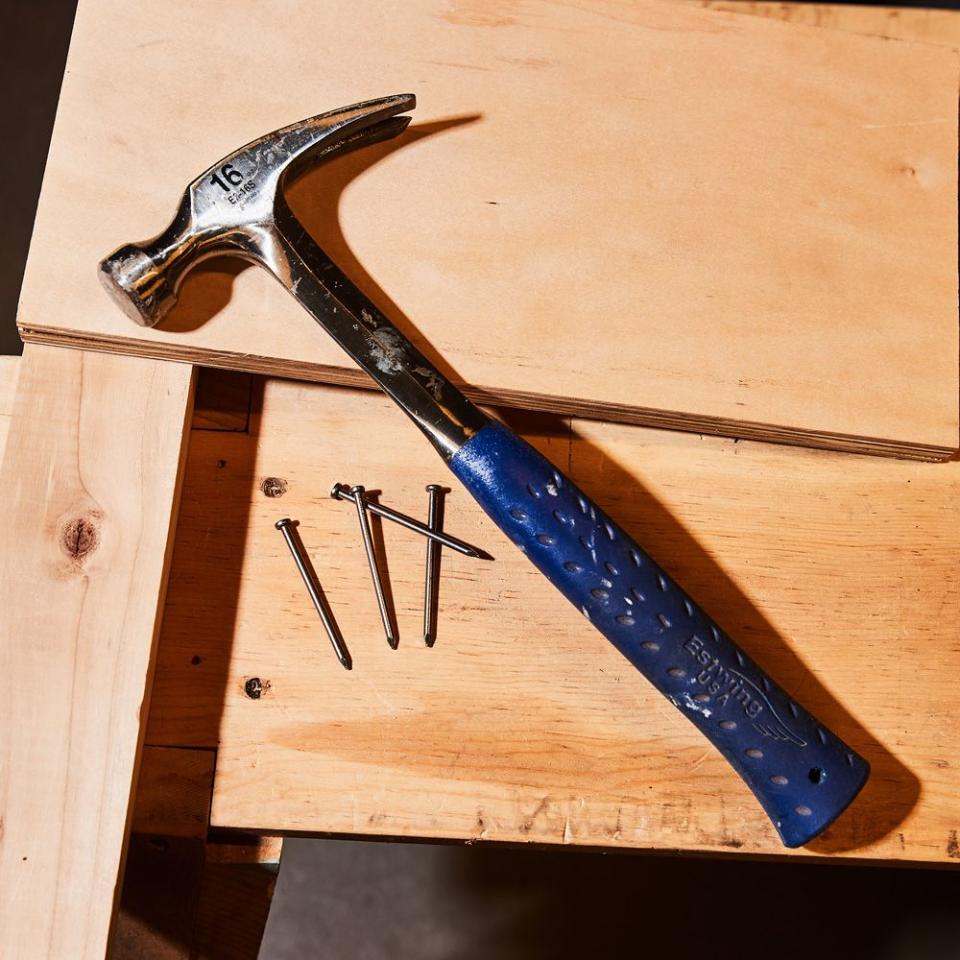
16 oz E3-16S
amazon.com
$24.98
Trevor RaabCMHT51398 16-oz Claw Hammer
Despite its low price, this Craftsman hammer is a perfectly fine option for those who just want a nice-sized, general use tool. Its 16-oz weight is well-suited for a wide range of hammering tasks, and the fiberglass handle helps minimize vibrations during those all-day projects. I’m especially impressed with the added overstrike protection below the head, which helps increase the lifespan of the handle.
The smooth face makes this option suitable for working on materials you don’t want dinged up, and as long you’re not trying to yank anything too hefty, the fiberglass handle should meet your light-duty nail pulling needs. Whether you’re a beginner or a pro who wants a backup hammer to keep in the tool box (or bring to a jobsite where higher-end hammers have a tendency to “walk away”) this is a great option.
Plus, if you want something with a bit more heft, a 20 oz straight claw version is available, still under $20. (Although I’d be cautious of prying anything too sturdy with that fiberglass handle).
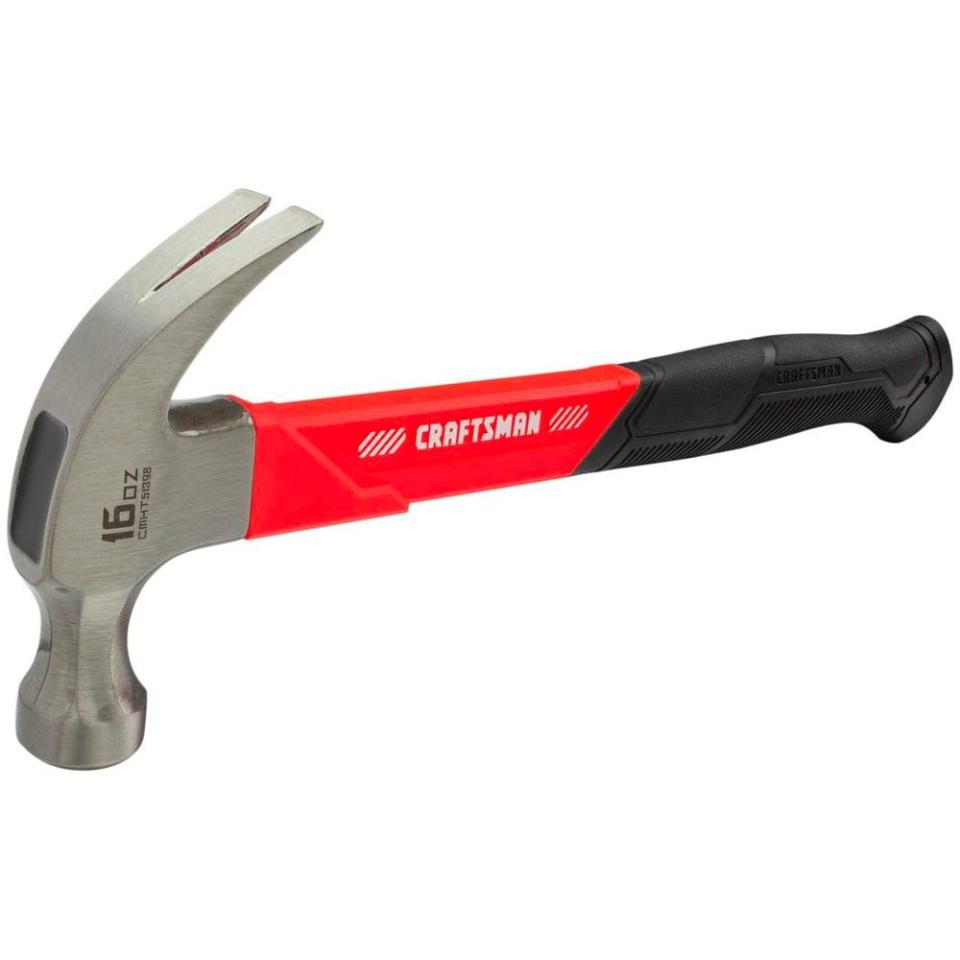
CMHT51398 16-oz Claw Hammer
lowes.com
$11.98
Stiletto TBM14RSC TiBone Mini-14
Yes, titanium hammers are extremely expensive, but so is physical therapy. If you use a hammer frequently, or find yourself with painful elbow or tendonitis issues, there’s a good chance this 14 oz Stiletto could be worth the extra cost.
Its titanium head features a replaceable steel face (either milled or smooth), as well as a 180-degree side puller for yanking any 6D - 16D nails you may come across. A magnetic nail starter saves time during high-production jobs and can really come in handy when you don’t have two hands available (although I’ve heard tales of this magnet decreasing its hold over time). The ribbed grip ensures you always have a secure hold as you swing too.
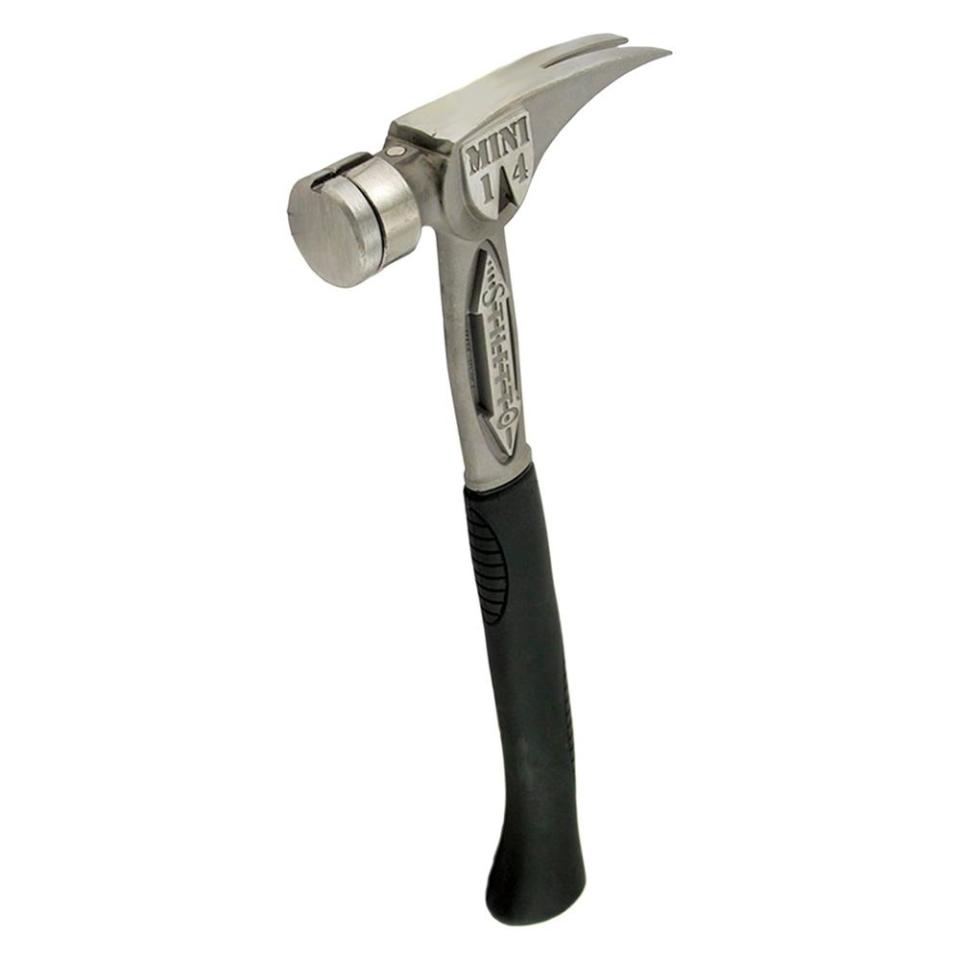
Stiletto TBM14RSC TiBone Mini-14
amazon.com
$227.98
10300 CF 1 California Framer
If you’re ready to dive into that DIY framing project, a standard claw hammer isn’t going to cut it. This 23-ounce Vaughn framing hammer has the heft and length needed to drive in beefy framing nails. The hammer's wide, milled face prevents slipping.
This model features a hickory handle for absorbing vibrations–essential for minimizing fatigue during all-day projects–and the magnetic nail holder is a nice perk for working in awkward or hard-to-reach spots.
Vaughn is a long-time favorite of amateur and pros alike, and while these hammers are not as light as titanium framers, their budget-friendly price, quality construction, and user-friendly design make them a great value.
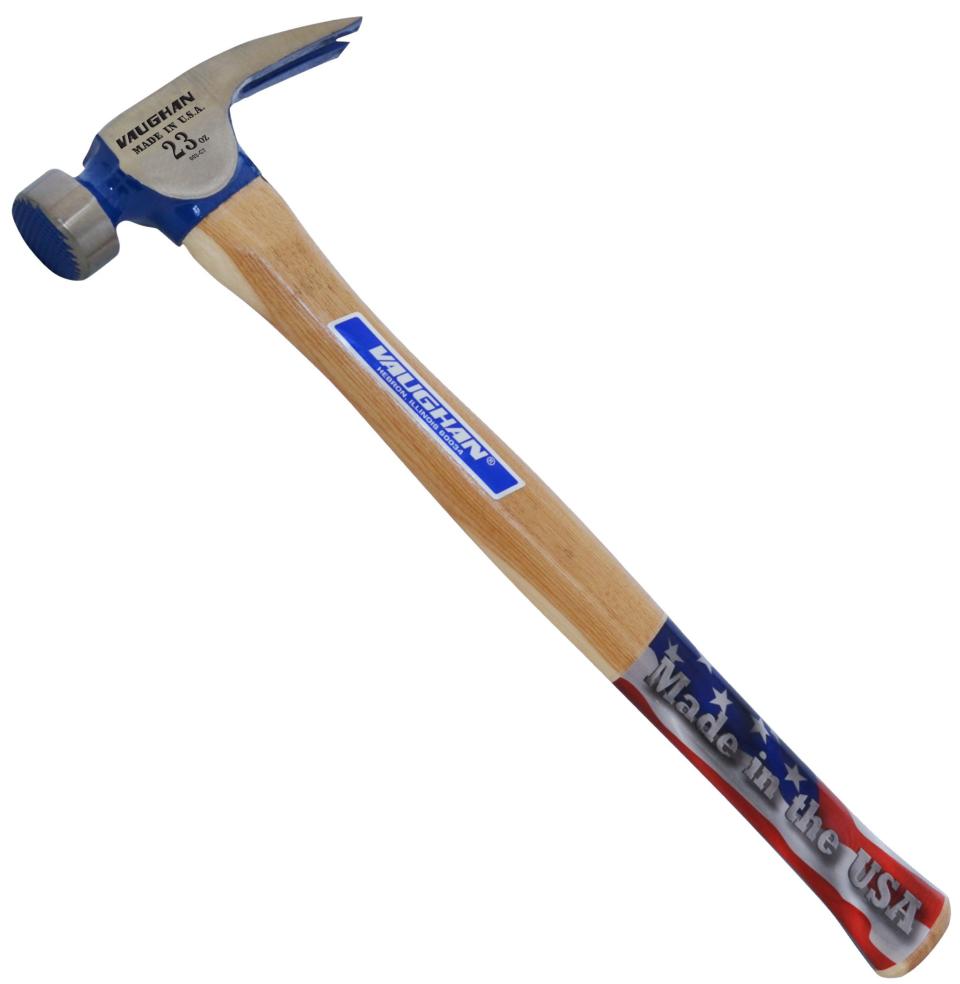
10300 CF 1 California Framer
amazon.com
$34.28
122-01 9 10-Ounce Little Pro Rip Hammer
There’s nothing quite like the heartbreaking feeling of dinging or denting a nearly-finished workpiece, which is why a decent finish hammer like this one is worth the purchase. Unlike beefier framing and all-purpose options, this hammers’ 10-ounce weight is light enough to control and swing with accuracy. Its smooth face is unlikely to leave any unsightly dents behind if you do miss your mark.
The hickory handle provides a natural, comfortable grip, and since you won’t be smashing or slamming the hammer around too much, the hickory isn't much of a liability in terms of durability. In addition to finish and cabinet makers, the light weight of this hammer also makes it well-suited for kids just starting out, or those with smaller hands or strength issues.
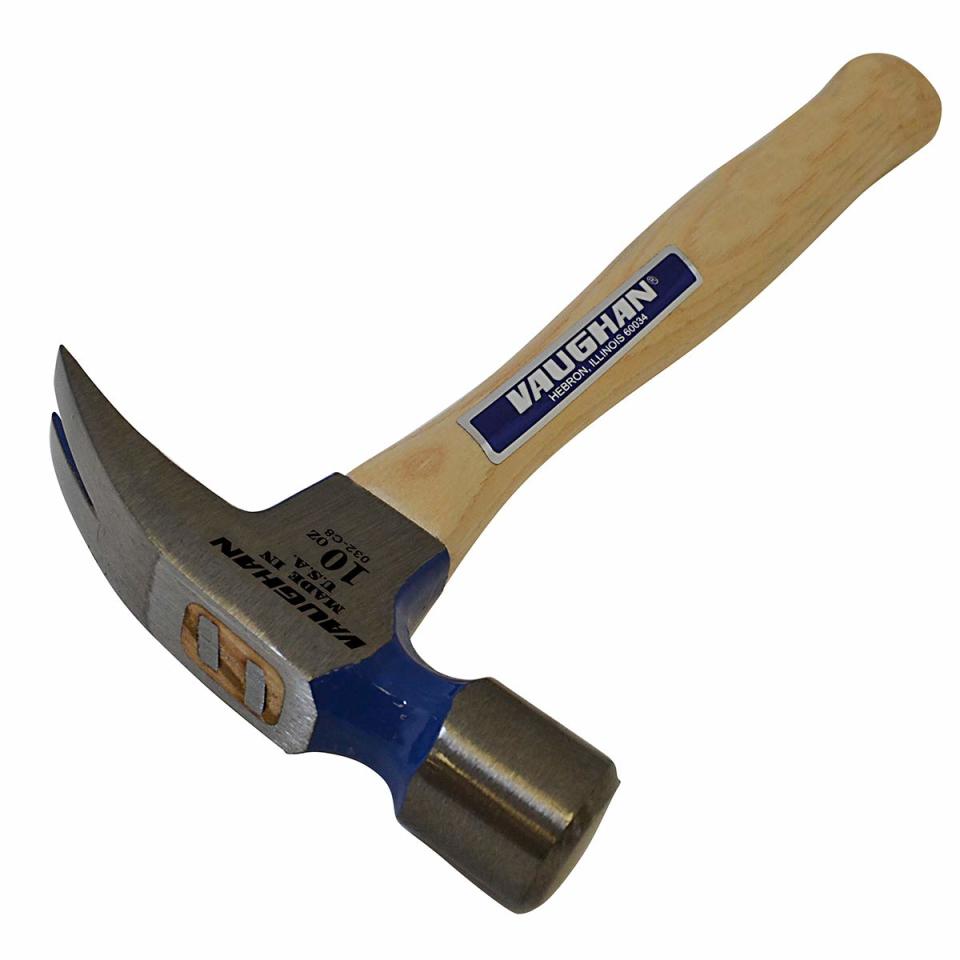
122-01 9 10-Ounce Little Pro Rip Hammer
amazon.com
$28.86
CINDEX18 Claw Hammer
If you do enough household projects, you’re bound to come across a nail that’s located in a position that a standard hammer can't reach. Thanks to its unique adjustable design, the claw of this Crescent hammer can swing into several different positions, allowing it to access tight and awkward spaces. A magnetic nail starter makes this hammer even more convenient for use in challenging areas, allowing you to drive nails one-handed.
When properly positioned, this hammer also essentially turns into a crowbar, making it convenient for generating a ton of leverage while prying apart lumber and crates. The all-metal construction is durable enough to handle heavy-duty tasks, and a rubber handle provides a tight grip however you decide to use it.
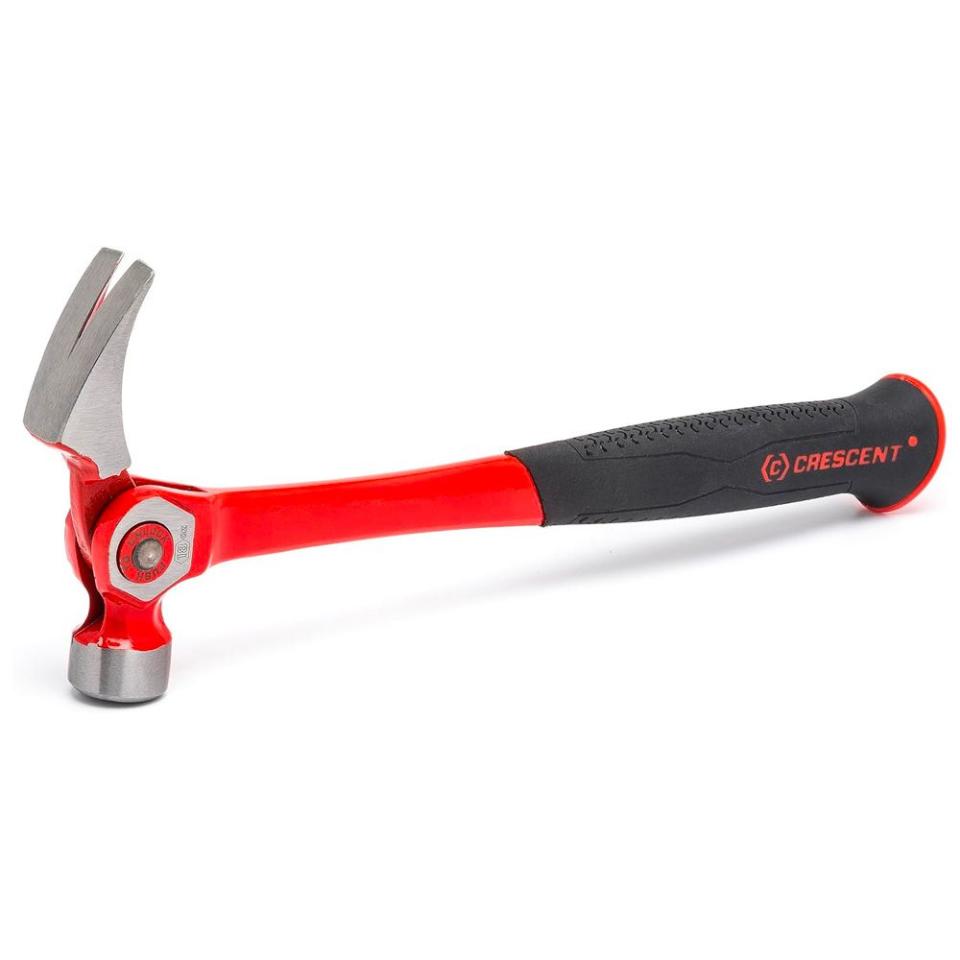
CINDEX18 Claw Hammer
amazon.com
$39.31
E6-24TM 24 Oz Hammertooth
This beast of a framing hammer doesn’t just look cool— its one-piece steel construction and heavy weight also make it practically indestructible. As long as you’re strong enough to comfortably use it (it also comes in a 22 oz version if you’re not), this well-balanced hammer is equally effective for efficiently driving framing nails as it is for smashing through demo projects. The hammer's impressive length enables maximum momentum for powerful swings.
The textured rubber grip ensures it stays safely in your grasp while swinging, and the signature “hammertooth” hook on the neck is designed to grab the edge of studs or joists between it and the claw, so you can easily pull or twist them into alignment for nailing.
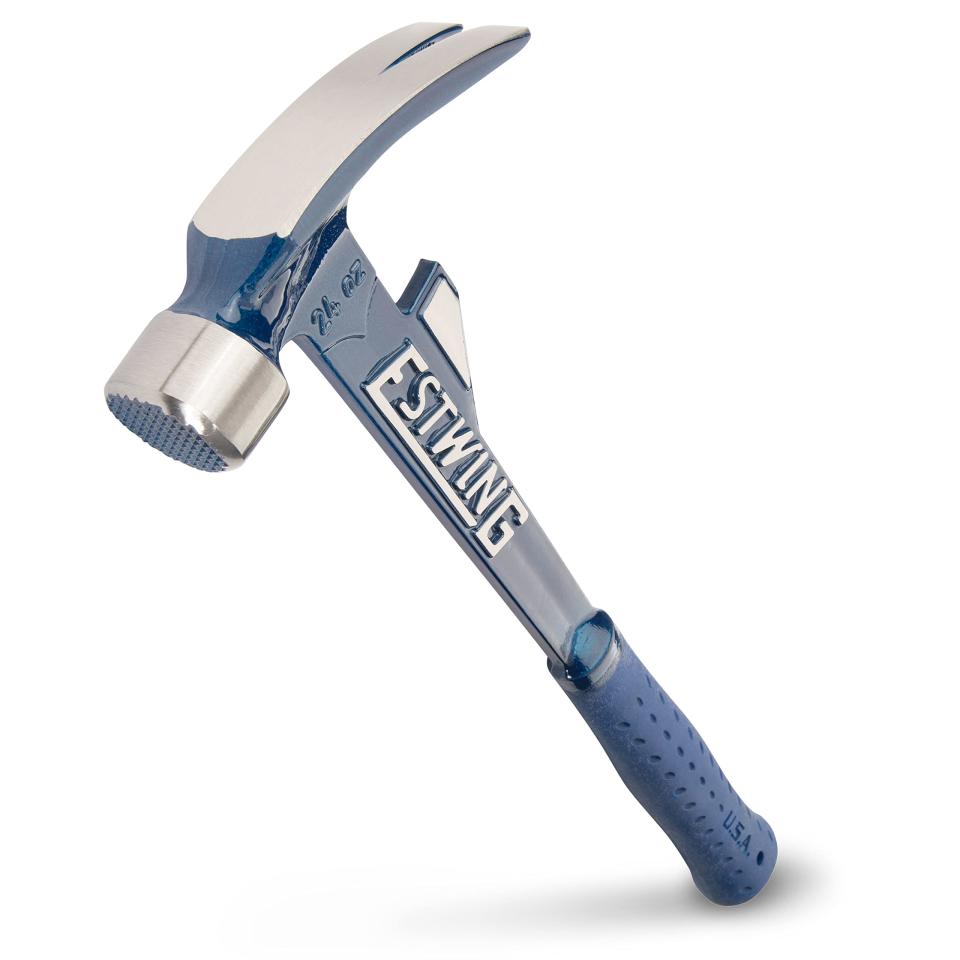
E6-24TM 24 Oz Hammertooth
amazon.com
$34.98
16oz Claw Hammer (1954889)
There’s a good reason why I’m currently on my fourth version of this hammer after misplacing or lending the others out: it’s a great tool. The fiberglass handle absorbs vibration well, and combined with the tacky yet soft rubber grip — my favorite of any hammer — it’s extremely comfortable to use.
The curved, ergonomic shape of the handle makes it easy to maintain a solid grip and prevents it from slipping out of your hand when swinging. Sure, this isn’t as durable as a metal-handled hammer, but as long as you’re not bashing it through demo projects, it’s going to hold up fine to light-duty, non-framing use. This is a fantastic general purpose hammer at a reasonable price.
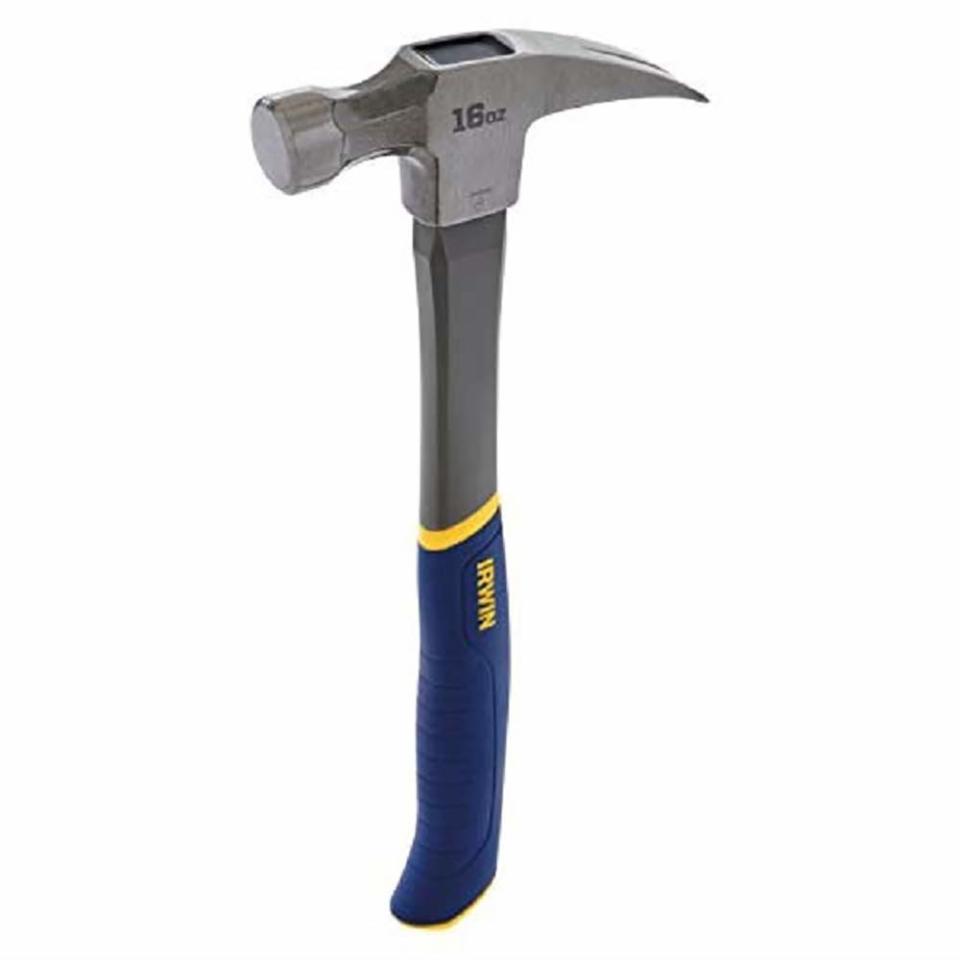
16oz Claw Hammer (1954889)
amazon.com
$9.99
DFH-12 Rubber Mallet
You might assume that this soft-faced mallet won’t get used too much, but I’ve found that it’s actually much more versatile than a traditional hammer when it comes to applying force. No, it can’t hammer nails, but with two soft faces — one slightly harder than the other — it can be used on a wide range of materials and surfaces, from tapping in dowels and tight carpentry joints, to shifting stubborn furniture pieces into place during assembly, and even automotive components that could be damaged by a metal face.
The curved handle is also comfortable to grip and hold onto, and the hickory construction makes this a lightweight tool overall.
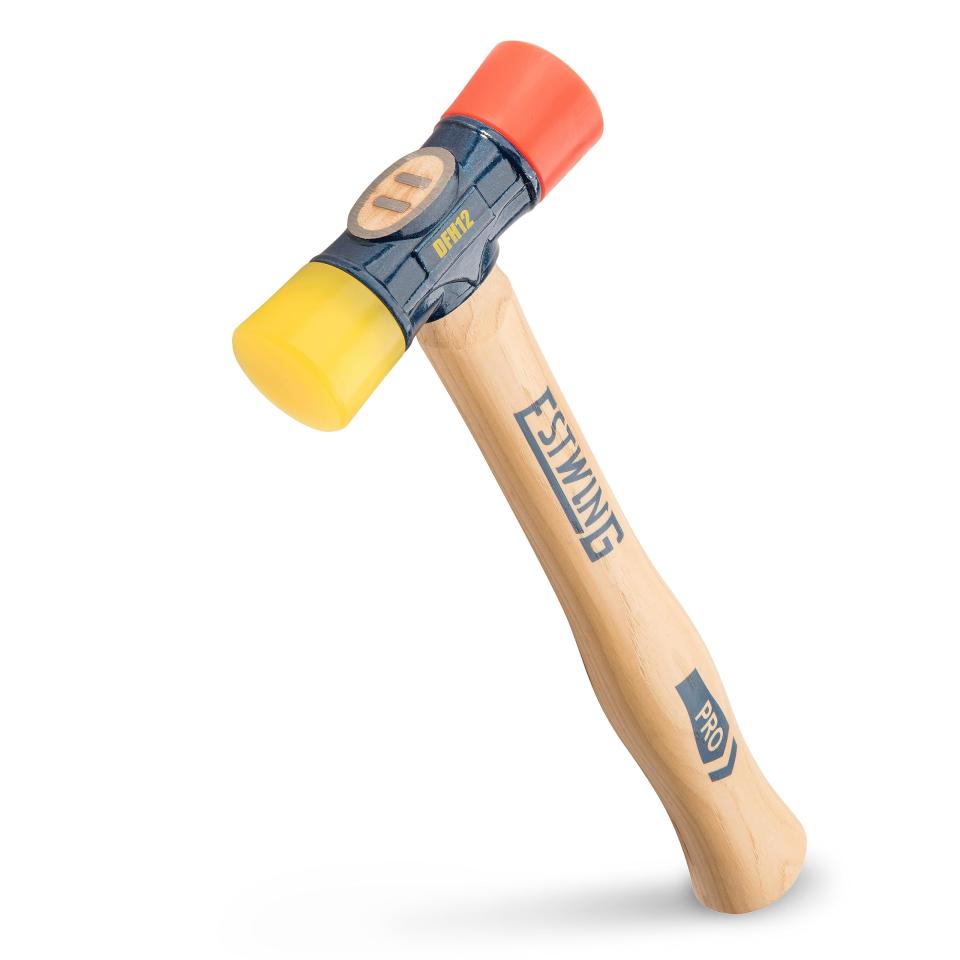
DFH-12 Rubber Mallet
amazon.com
$17.17
Hammer Q&A With Expert Alex Rennie
What’s the best way to take care of a hammer?
With no moving parts, and designed with durability in mind, hammers don’t require the regular maintenance that other tools do. That being said, there are some things you can do to keep it in good working order.
If your hammer has a wooden handle, make sure to keep it out of the elements when not in use (don’t leave it outside or in a truck bed) and regularly inspect it for cracks or splintering. Even a small amount of structural damage to wood or fiberglass handles — usually a result of using it for rough demolition tasks that it’s not meant for — can result in unexpected breakage, or the head becoming loose and flying off mid-swing. Also, regardless of the type or material, you should always clean your hammer after use.
You can also reduce unnecessary wear and tear by storing your hammer on a toolbelt with a dedicated hammer loop. This not only saves you from having to track down your hammer every time you need it, it keeps it off the ground where it can get stepped on, kicked, or run over by a vehicle. It also prevents anyone else from walking off with it, intentionally or by accident.
How do I strike a nail accurately?
First, grip the handle towards the bottom— there should be some kind of dip or curve that fits into your hand nicely. Give it a couple of practice swings to get a feel for the balance, and make sure the weight isn’t too heavy for you to control. Then, position the nail on the wood where you want to drive it in — holding it near the top, not the bottom — and make sure it’s perpendicular to the wood surface. Then, give the nail a couple of light taps to set it in the wood, pull the hammer back in an arc by bending your elbow, and swing it forward to strike the nail.
It’s important during this step that the hammer face is completely perpendicular to the nail, otherwise it can slip off the side, or bend the nail. Continue striking until the nail head is flush with the surface of the wood.
Try not to get too frustrated if striking the nail is challenging at first. The framers you see on job sites that sink nail after nail in 2 swings have had years of practice to get that good. Once you get a feel for the physics of the hammering motion, you’ll be able to work more efficiently and accurately. Remember, let the hammer do the work.
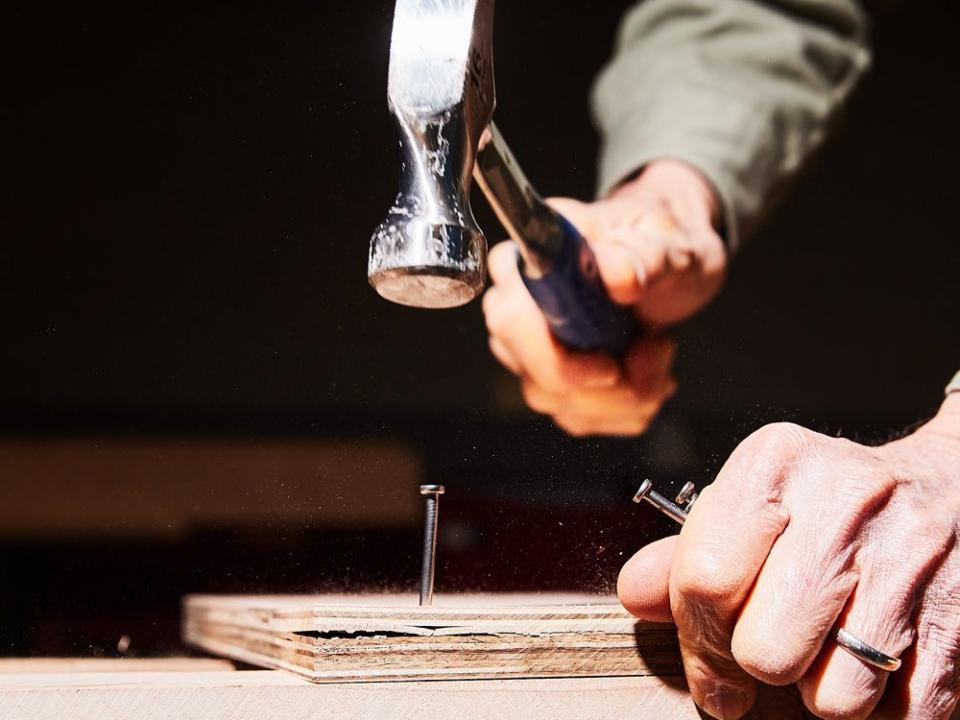
You Might Also Like

